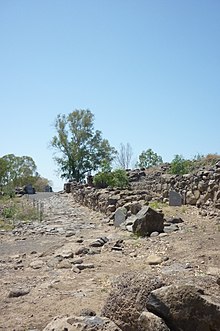Bethsaida
Bethsaida ("House of (fish) catching" or "House of Hunting") is a village in the ancient Gaulanitis (Golan) on the Sea of Galilee . The place is known as the birthplace of the apostles Peter , Andrew and Philip ( Joh 1,44 EU ). In later writings around the year 400, u. a. of Chrysostom and Hieronymus , the apostles James and John are also mentioned as coming from Bethsaida. According to the evangelist Matthew, Jesus names Bethsaida as one of the Galilean places ( which he criticized as unwilling to convert) - together with Chorazin , 8 km away - where he performed the most miracles ( Mt 11 : 20-22 EU ). The healing of a blind man is localized near Bethsaida ( Mk 8.22-26 EU ).
The ruins of the ancient village were discovered by Bargil Pixner during excavations in 1987 on the hill et-Tell .
location
Et-Tell is north of the Sea of Galilee, east of the mouth of the Jordan into the lake. It is located on road 886 about 1.5 km from the current shore of the lake. The tell covers an area of approximately 80,000 square meters.
Settlement periods
The first excavations carried out by the archaeologist of the University of Haifa R. Arav in 1987 and 1989 made it clear that the place was inhabited in the following periods in antiquity: In the early Bronze Age (approx. 3300–2300 BC), the Iron Age (approx. 1000 - 587 BC) and the Hellenistic- Roman period (336 - 30 BC).
Iron age
So far, archaeologists assume that Bethsaida was around 1000 BC. Was founded. Due to the size and importance of the finds from this period, the place could have been the capital of the Kingdom of Geshur. Remnants of a wall up to 6 meters thick were found, partly an inner and an outer city wall.
Most important, however, is the discovery of the gate system, which consisted of an outer and an inner gate (the latter with four chambers) and a gate altar ( bima ) in front of the inner gate.
The altar includes a basalt stele with the image of a bull with a dagger, which is supposed to represent the Aramaic god Hadad . Furthermore, fragments of a basin, a horned altar and bones of sacrificed animals were found at the sacrificial site.
The city was founded by the Assyrian king Tiglath-Pileser III. in 734 BC Conquered (2 Kings 15, 29).
Hellenistic-Roman period
We learn something about the importance of Bethsaida from Flavius Josephus . He reports that King Philip raised the village of Bethsaida to the rank of a city ( polis ), "provided it with residents and sources of income" and changed the name of the city to Julia-Livia in honor of the wife of Emperor Augustus in 30. Four years later, Philip, son of Herod the Great and Tetrarch of Gaulanitis, died. He was buried in Julias (Bethsaida) - according to Flavius Josephus - "with great pomp". Several houses from this period (3rd century BC to 1st century) were uncovered, in particular a fisherman's house and a wine-grower house. The so-called fisherman's house got its name because numerous devices that were used for fishing were found here. In the so-called wine grower's house, four wine jugs were found in the wine cellar and a shard with an engraved cross in the living area near the doorway to the inner courtyard.
These finds indicate the importance of fishing and viticulture for the local economy. Remains of a limestone building and the discovery of incense scoops in its ruins are interpreted by scientists as the remains of the temple that King Philip built in honor of Juliet Livia.
Byzantine period
Finds from 2017 give evidence of an "important, preciously decorated" Byzantine church.
Individual evidence
- ^ Heinz-Wolfgang Kuhn: Betsaida / Bethsaida - Julias (et-Tell). The first 25 years of the excavation (1987-2011) . Vandenhoeck & Ruprecht GmbH & Co. KG, Göttingen 2015, ISBN 978-3-525-54025-1 , p. 154 .
- ^ Rainer Metzner: The celebrities in the New Testament. A prosopographic commentary . Vandenhoeck & Ruprecht GmbH & Co. KG, Göttingen 2015, ISBN 978-3-525-53967-5 , p. 233 .
- ↑ Markus Springer: The village of Peter - has the "right" Bethsaida now been found? In: Sunday paper (Bavaria) . August 8, 2017 ( sonntagsblatt.de ).
literature
- Georg Beer : Iulias 1 . In: Paulys Realencyclopadie der classischen Antiquity Science (RE). Volume X, 1, Stuttgart 1918, Col. 97.
- Immanuel Benzinger : Bethsaida 1 . In: Paulys Realencyclopadie der classischen Antiquity Science (RE). Volume III, 1, Stuttgart 1897, Col. 365.
- Rami Arav, Richard Freund (Ed.): Bethsaida. A City by the North Shore of the Sea of Galilee 1-4. Truman State University Press 1995-2009.
- Monika Bernett , Othmar Keel : Moon, bull and cult at the city gate: The stele of Betsaida (et-Tell) (= Orbis biblicus et orientalis 161). Friborg, Göttingen 1998. ISBN 3-7278-1176-5
- Gabriele Faßbeck, Sandra Fortner, Andrea Rottloff , Jürgen Zangenberg (eds.): Life at Lake Gennesaret: Discoveries of cultural history in a biblical region. Zabern's illustrated books on archeology / special volumes from the ancient world. Mainz, Philipp von Zabern 2003. ISBN 3-8053-2914-8
- Sandra Ann Fortner: The ceramics and small finds from Bethsaida-Iulias on the Sea of Galilee, Israel , Diss. 2005, Munich 2008. [1]
Web links
- Official excavation reports
- Friedrich Schipper: Bethsaida / Iulias. In: Michaela Bauks, Klaus Koenen, Stefan Alkier (Eds.): The Scientific Biblical Lexicon on the Internet (WiBiLex), Stuttgart 2006 ff.
- In the Jewish Encyclopedia
Coordinates: 32 ° 54 ′ 35.8 " N , 35 ° 37 ′ 49.9" E






